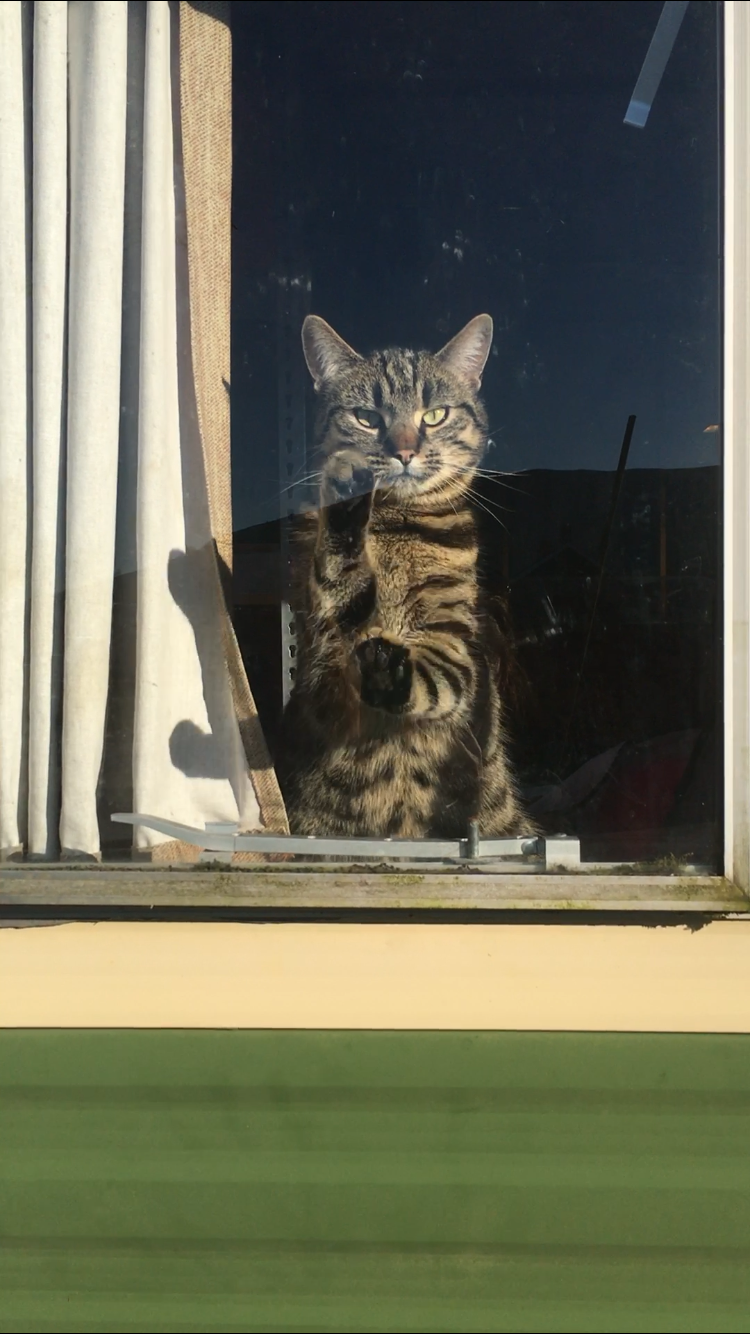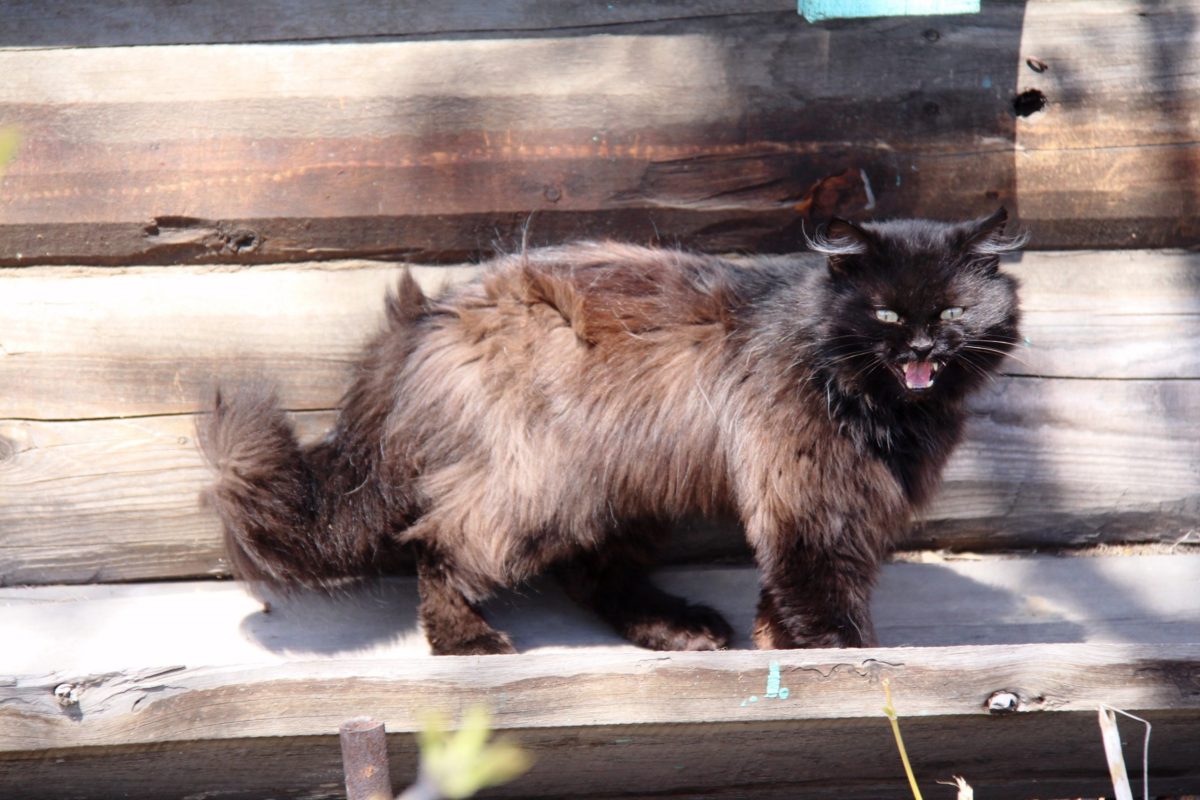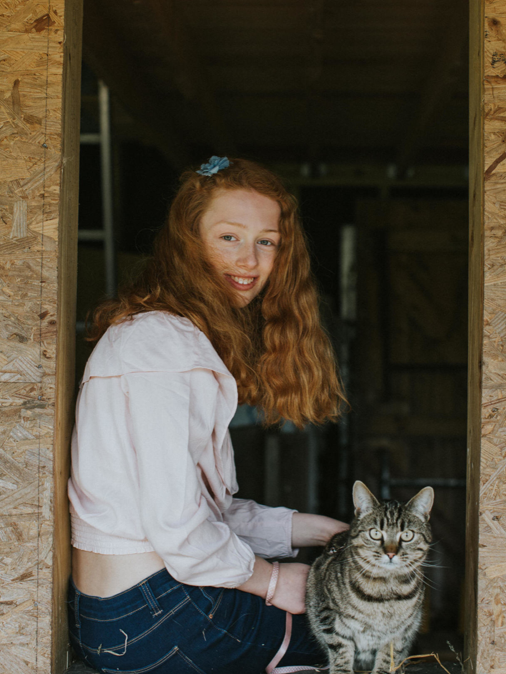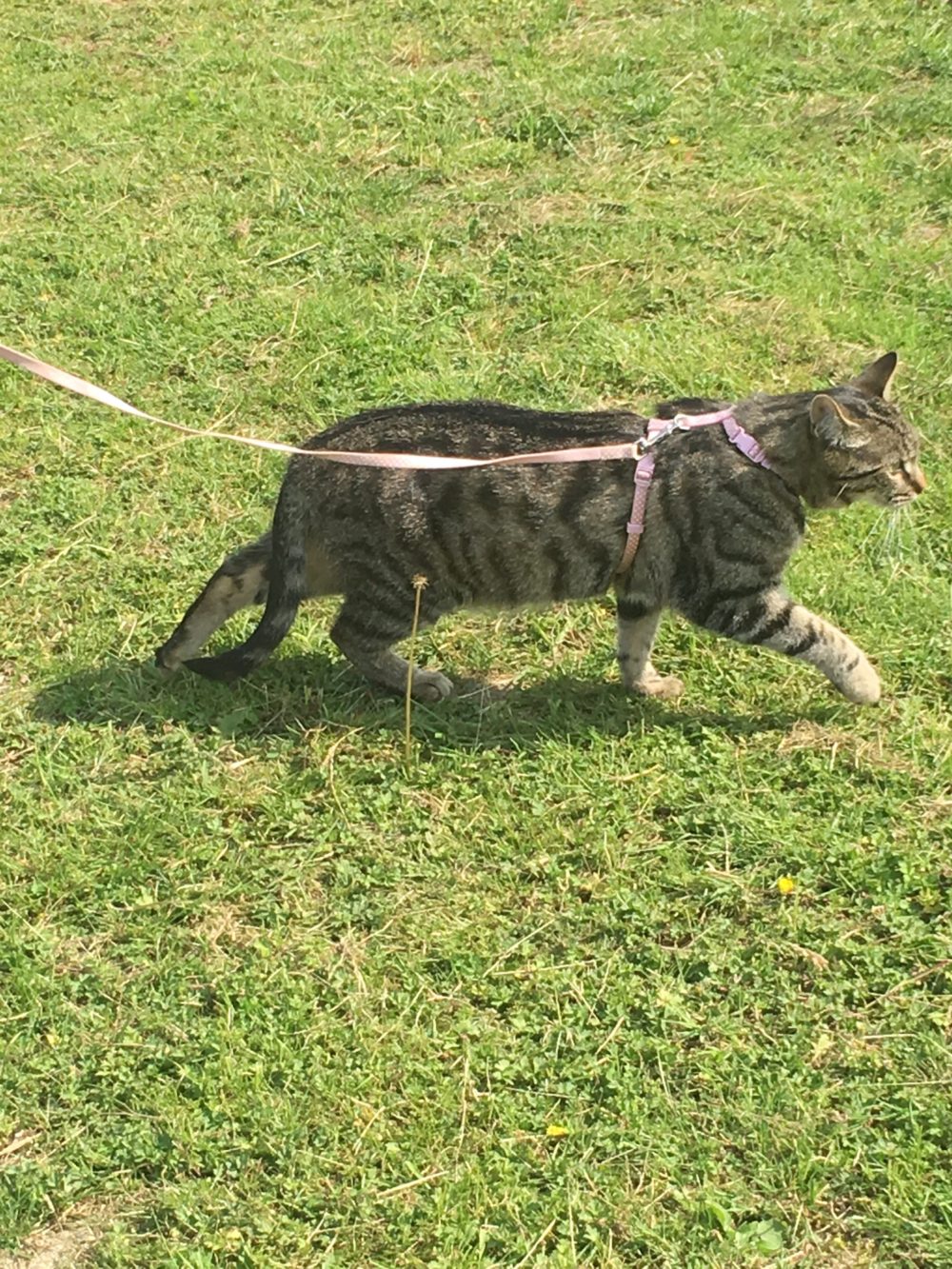
Do indoor cats need outside time? Why does my cat refuse to go outside?
The indoor versus outdoor cat is a hugely debatable issue amongst cat owners. We’ve previously explored the advantages and disadvantages of both options in our article ‘Should I let my cat outside at night? Indoor or outdoor cat’. It really is a personal decision, and factors such as where you live, your cat’s personality and what they are used to are all factors that cat owners consider when making this decision.
We have a rather unique arrangement whereby one of our cats, Misty, is an outdoor daytime cat. She is let out in the morning and returns early afternoon. Misty is then kept in the safety of the indoors overnight. She is an avid hunter and despite our initial reservations and fears when she first when out, seeing the pleasure and excitement when we let her out in the mornings, we are satisfied we have made the right choice. Our second cat, Boo, has never wanted to go outside. She is happy and content observing the busyness of the outside world from the safety of the indoors. However, we explored the issue of whether did she actually need some outside time? Would it be good for her to experience some of the excitement and wonders of the outside but in a safe and controlled environment?
Does my indoor cat need outside time?
An indoor cat can live perfectly happy and content without ever venturing outside. However, it is very important to ensure that they are still mentally and physically stimulated to avoid stress, anxiety or boredom setting in. Many of cat’s natural instincts include exploring, investigating smells, marking their territory and of course, hunting. By allowing our cats a safe controlled experience of exploring the wonders and sensations of the outside, the cat’s natural instincts can be more then satisfied. There are many ways an indoor cat can have some quality, safe outside time. Some of these options include:
- A catio
- A secured, enclosed garden
- Cat run / cat enclosure
- Carrying your cat outside
- Walking your cat on a leash
- Taking your cat for walks in a walker or stroller
- Placing your cat in a personal cat carrier
These options vary greatly in effort, cost, suitability. Choose what best suits your cat and your lifestyle and don’t be afraid to use more than one method.
Catio
 A catio is an outside, safe enclosure for cats. Catios can come in all shapes and designs, to whatever works for your house and garden. It allows cats the access to come and go from the indoors to an enclosed outside area as they please. We can 100%, categorically say, that building a catio for our cats was the best thing we have ever done. You can read all about our catio build here, ‘What is a catio / cat enclosure?’. Catios can be as simple or as elaborate as your wish. If DIY is not for you, there are companies that specialize in building bespoke cat enclosures, or catios can be purchased readymade. There are many benefits to a catio:
A catio is an outside, safe enclosure for cats. Catios can come in all shapes and designs, to whatever works for your house and garden. It allows cats the access to come and go from the indoors to an enclosed outside area as they please. We can 100%, categorically say, that building a catio for our cats was the best thing we have ever done. You can read all about our catio build here, ‘What is a catio / cat enclosure?’. Catios can be as simple or as elaborate as your wish. If DIY is not for you, there are companies that specialize in building bespoke cat enclosures, or catios can be purchased readymade. There are many benefits to a catio:
- A catio can provide the peace of mind that your cat is safe at all times.
- It enables an indoor cat to experience fresh air, exercise and a taste of the adventures of the outdoor in a safe enclosed area.
- Outside hazards such as poisons, vehicles, neighboring cats and dogs are no longer a threat to your cat.
- Injury and diseases are less likely to occur with indoor cats thereby reducing any associated costs and stress.
- The birds and wildlife can also enjoy your garden without the risk of being hunted by your cat.
- A catio will provide additional space in a multi cat household.
- There are no risks of your cat wandering into your neighbor’s garden, or even further afield.
- If the catio is large enough it can be an area that you too can enjoy with your cat. Placing a garden chair in the catio means you too can enjoy the space and spend quality time with your cats.
Secured garden
 Many cat owners are now securing their gardens with secure fencing to enable their cats to enjoy the outdoors but eliminating the risk of them wandering further. There are many providers that sell and install this type of fencing but in essence it is a system of high steel mesh fencing with a fence top barrier that fits around the perimeter of the garden. It is important to identify every potential jump pad such as a window ledge or shed roof, and secure even the smallest of corners or spaces where a cat could escape. Many cat owners are now opting for such fencing systems in their gardens, but it must be remembered that the fence must be 100% cat proof to be effective. However, this option isn’t always practical with very large gardens and is certainly the most expensive from all the options listed here in this article.
Many cat owners are now securing their gardens with secure fencing to enable their cats to enjoy the outdoors but eliminating the risk of them wandering further. There are many providers that sell and install this type of fencing but in essence it is a system of high steel mesh fencing with a fence top barrier that fits around the perimeter of the garden. It is important to identify every potential jump pad such as a window ledge or shed roof, and secure even the smallest of corners or spaces where a cat could escape. Many cat owners are now opting for such fencing systems in their gardens, but it must be remembered that the fence must be 100% cat proof to be effective. However, this option isn’t always practical with very large gardens and is certainly the most expensive from all the options listed here in this article.
Cat run
A cat run, cat enclosure or cat gazebo is essentially an enclosed play area that can be erected outside for your cat to spend some time in the garden safely and securely. Some are pop up and are easily folded and stored away when not in use whilst others are erected as a permanent feature in your outside space. Some come with more elaborate features including perches and areas for climbing. These structures usually require you to carry your cat to the outside enclosure. There are some models which come with a cat tunnel whereby your cat can come and go from the house to the outside area as they wish. These connectors enable independence for your cat to come as and when she decides.
Carrying your cat
This is something we often do – simply pick up Boo in our arms and take a leisurely stroll around the garden. This is only done for short spurts of time – about 5 – 10 minutes at any one time. This works as our cat is quite happy, and feels safe, in the comfort of our arms. She doesn’t try to jump down or run away. She is perfectly relaxed, enjoying the fresh air and absorbing the sight and smells of the garden. This is a great way to introduce your cat to the outdoors. The noises, sights and smells of the outside can be overwhelming or even frightening for a young kitten. Gentle introductions such as carrying them can lead to longer periods outdoor such as leash walking, and pet carriers.
Walking on a leash
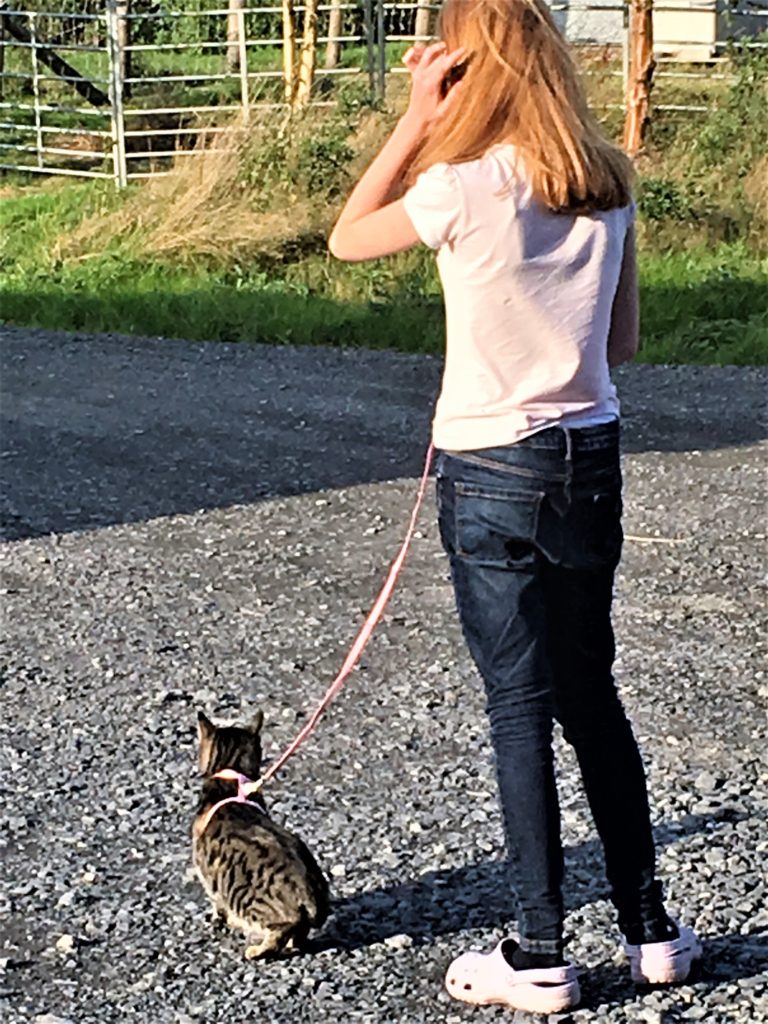 We’ve had a few strange looks as passers by see us walking our cat, Boo, on a leash! This was something that our cat took to very quickly and without resistance. Starting from a young age certainly helps if walking your cat on a leash is something you wish to try. The benefits of walking your cat on a leash include:
We’ve had a few strange looks as passers by see us walking our cat, Boo, on a leash! This was something that our cat took to very quickly and without resistance. Starting from a young age certainly helps if walking your cat on a leash is something you wish to try. The benefits of walking your cat on a leash include:
- A good walk ensures your cat has ample exercise.
- The leash ensures your cat is safe and no danger of running away if anything startles her, or something in the distance grabs her attention.
- Allows your cat to explore the outside safely. The touch of grass, the different smells, the rustling leaves, the cautious birds nearby are all there to excite and heighten the senses.
Allow your cat to lead you – this is very different to taking a dog for a walk! Let them guide you to where they wish to explore. On a sunny day, they may simply enjoy lying in the grass for a while or rolling around enjoying the warm sunshine.
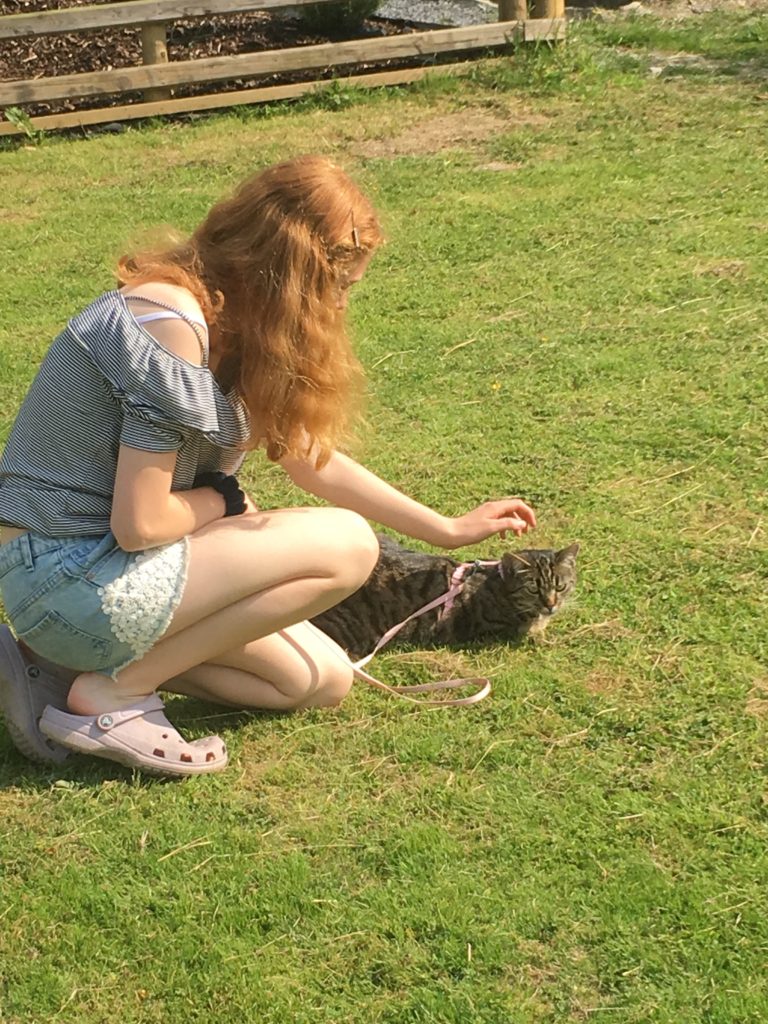
Here are our top tips for taking your cat for a walk on a leash:
- Not all cats will take to this. Some cats will enjoy this from the outset, for some it may be a slow but steady transition, but for some it simply won’t be for them at all. There are plenty of other methods to allow your cat safe outdoor time. Inflicting stress or anxiety on your cat will not benefit their wellbeing.
- Buy a cat harness and attach the leash to the harness. For safety reasons, do not attach the leash to their collar. Get your cat accustomed to the harness and lead indoors before you venture outside.
- Start the leash training slowly. Rewarding with praise and treats will associate the leash as a positive experience. Keep calm and be patient.
- Once your cat is happy with the harness and leash you are ready to venture outdoors. Your cat may be very nervous or highly excitable if she has never experienced the outdoors previously. Keep the first few times you go outside as short sessions and let your cat lead you to where she feels safe. Ensure the first visits are in a calm environment away from traffic, other cats, loud noises or dogs.
- Never leave your cat tied up outside on a leash and never leave your cat unattended with the harness and leash on.
There are a wide range of cat harnesses and leads available on the market. Ensure it is a snug but comfortable fit for your cat.
Walker or stroller
Although this isn’t a method we’ve tried and tested, it certainly one our teenage daughter is eager to try out. It’s essentially a stroller to take your cat for a walk, just like you would with a baby or small child. And given the range of pet strollers available on the market it would seem that this is a rather popular method for allowing your cat to enjoy the outdoors. They provide a safe way of taking your cat for a walk outside. This could be an excellent option for an elderly cat who may have trouble walking but would still enjoy some fresh air and a view of the outside world.
Personal cat carrier
Taking your cat with you travelling was once an idea that would never be entertained. But devoted cat owners are now reluctant to leave their beloved cats at home and they therefore take them along with them. This requires planning and organization and a personal cat carrier is a key item. What a fantastic view your cat gets in one of these specially designed carriers. You don’t have to plan a long elaborate trip to take advantage of these carriers. A walk in the park, a forest exploration or a relaxing Sunday stroll can all be a great excuse to get your cat to enjoy the beauty of the outdoors. If you have an up and coming trip planned with your cat, be sure to check out our article ‘Tips for travelling with your cat – by car, train, bus or plane’.
Why does my cat refuse to go outside?
Despite creating a safe and secure environment outside, some cats can still show fear and refusal to go outside. There are several possible reasons for this:
- Moving to a new house or any changes in the family arrangements can be confusing and an anxious time for cats. If a cat was an outdoor cat at a previous home, she may just need a little time to adjust to the new surroundings.
- If a cat has lived happily as an indoor cat for all of her life, and many cats certainly do adapt to a happy, fulfilled life indoors, then there is simply no need to cause unnecessary distress.
- Introducing new routines and ideas are, generally, more accepting by a young cat or kitten.
- Some cats may be wary of new structures or adventures whilst others will be so inquisitive that they are investigating and exploring straight away.
- Introduce the catio, leash, outdoor enclosure or any of the outdoor options slowly. Carry your cat, remain calm and let her explore and evaluate the new surroundings at her own pace.
- Keep initial outings short so she builds up trust and security and feels safe knowing that the familiarity of home is never far away.
- Despite slow, initial introductions, some cats simply may not want to go outside. If this is the case do not force the issue. She may be quite happy to observe the outside world from a window perch.
- If there are any sudden changes in your cat’s behavior or you have any concerns, please contact your veterinary for further advice.
Other articles that you may find of interest:
Creating the ultimate cat friendly garden – 10 top tips
How to keep your cat happy – 10 key factors
What is a catio / cat enclosure?
Should I let my cat outside at night? Indoor or outdoor cat?



